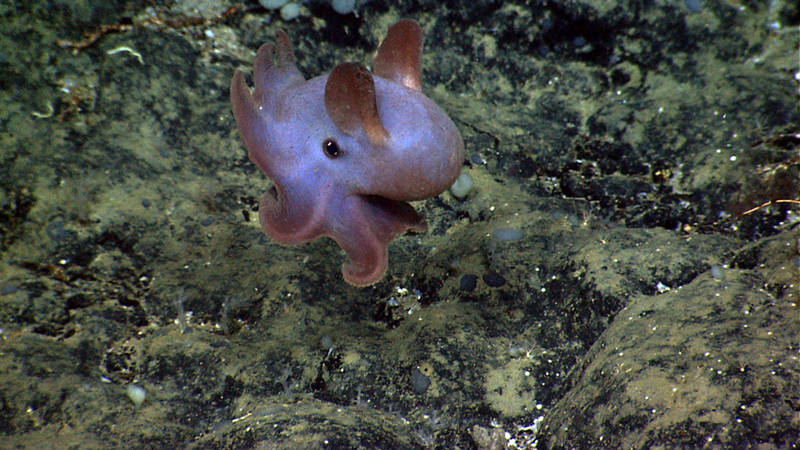
This dumbo octopus was our second cephalopod of the day and a dive highlight! Image courtesy of NOAA Okeanos Explorer Program, Our Deepwater Backyard: Exploring Atlantic Canyons and Seamounts 2014. Download larger version (jpg, 2.0 MB).

This dumbo octopus was our second cephalopod of the day and a dive highlight! Image courtesy of NOAA Okeanos Explorer Program, Our Deepwater Backyard: Exploring Atlantic Canyons and Seamounts 2014. Download larger version (jpg, 2.0 MB).
Okeanos Explorer EX1404L3
Dive 07: Atlantis II Seamount Complex. Video courtesy of NOAA Office of Ocean Exploration and Research. Download (mp4, 34.2 MB)
Today’s dive was the first ever to explore the Atlantis II Seamount Complex and what a great dive it was! Remotely operated vehicle Deep Discoverer (D2) landed at a depth of 2,786 meters on hard substrate with manganese staining and some evidence of pillow lava flows as well as pteropod shells, polychaete worms, and shrimp. Shortly after beginning our investigation of the northwest ridge, D2 encountered octocorals, cup corals, precious corals, sponges, a dandelion siphonophore, sea stars, and anemones. This first portion of the dive had a lot of fauna, but the majority of it was very small, potentially indicating frequent disruptions or a lack of resources. As we continued upslope, precious corals (including a colony that was over 1.5 meters) were the dominant group of corals with others including black corals, bamboo corals, and other octocorals. Other fauna in this area included multiple sea cucumbers, a high diversity and density of sponges, sea urchins, squat lobsters, sea stars, a few different species of fish, shrimp, anemones, both stalked and non-stalked crinoids, a vampire squid, eels, and surprisingly few brittle stars. D2 also came across a carbonate outcrop that appeared to be a drowned reef overrun with lava from when this seamount was exposed during a time of lower sea level. The latter portion of the dive had many highlights, including potential range extensions for two species of precious corals, a dumbo octopus, a rarely imaged sea spider with a large egg mass, groups of large barnacles, a sea toad, a rare swimming isopod, and a striking area of rock covered in a glassy manganese coating devoid of life.